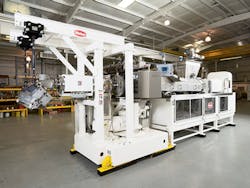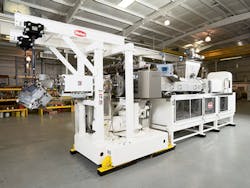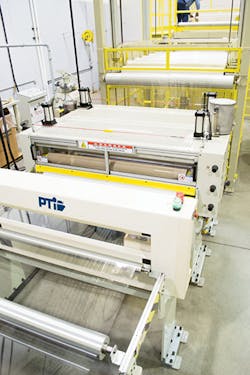PLA dried, extruded inline by specialty equipment
Polylactic acid (PLA) has gotten a great deal of attention in recent years as a biomaterial, derived from nonpetroleum precursors. Its advantages arise from evolving consumer preferences for compostable materials.
Sheet extrusion of PLA, similar in some ways to the production of PET, requires removing the moisture from this extremely hygroscopic material. Another challenge is minimizing loss of molecular weight, which yields a brittle product. The challenges of processing PLA can be formidable.
Thanks to advances in technology, pre-drying no longer is necessary for extruding PLA. In-line setups can remove volatiles prior to extruding the sheet and delivering it to roll stacks. At least four companies, some working with partners, currently deliver this technology.
Suppliers of PLA sheet lines with integral moisture removal include: Davis-Standard LLC, Pawcatuck, Conn., which partners with Leistritz Aktiengesellschaft, Nuremburg, Germany, and Gneuss Kunststofftechnik GmbH, Bad Oeynhausen, Germany; Macro Engineering, Mississauga, Ontario; Processing Technologies International (PTi), Aurora, Ill., which partners with Luigi Bandera, Busto Arsizio, Italy; and Welex, York, Pa.
SPECIALTY PLA EXTRUSION LINE
MEET CHALLENGES
The first Welex Converge conical twin-screw (CTS) sheet line for PLA processes the Ingeo biopolymer, from NatureWorks LLC, Minnetonka, Minn., and feeds the sheet directly to an in-line thermoforming process used by a manufacturer of disposable food-service ware.
Based on co-rotating, conical twin-screw technology, the Welex Converge CTS sheet line processes PLA with moisture content up to 2,500 parts per million (ppm) while eliminating the need to crystallize or pre-dry the material. Output is as much as 3,500 pounds per hour at 392 degrees Fahrenheit. Minimizing process temperatures helps avoid molecular weight degradation, benefitting both first-pass parts and post-industrial regrind.
The surface moisture is removed by means of a low vacuum applied at the feed area. After the material is plasticized in the first stage of the extruder, a decompression section applies a high vacuum through a large vent to complete moisture removal.
Large thrust bearings produce high pressure, and a large screw diameter generates high torque. As a result, the Converge CTS line processes PLA effectively at the lowest possible melt temperature, says Jim Nissel, international sales director with Welex. Benefits of a low melt temperature include energy efficiency, higher melt strength, less monomer re-formation and color preservation.
Maximum melt strength reduces sagging at the nip as well as surface blemishes. Minimum monomer formation decreases plate-out on the polishing rolls. Keeping the temperature as low as possible helps preserve color. Because yellowing due to heat history can be avoided, blue-tone masterbatch, which is used to compensate for color degradation, is not needed.
Welex Converge CTS systems are available to process from 1,100 to 4,000 pounds per hour, handling bulk densities as low as 150 grams per liter. The screws are half the length and weight of conventional parallel twin screws, so they can be more easily removed, with almost no added clearance required because of the pivoting barrel. The system also has a large feed throat opening, providing the ability to add fillers without the added cost and complexity of side feeders.
Davis-Standard offers sheet extrusion systems for PLA via its own single-screw systems or by partnering with Gneuss, integrating the Gneuss single-screw MRS extruder into the Davis-Standard sheet line, according to Steven R. DeAngelis, VP of the sheet and foam group. For multiscrew systems, Davis-Standard partners with Leistritz for co-rotating, twin-screw extrusion technology.
The Davis-Standard single-screw extrusion setup uses a smooth-bore extruder and high-volume volatiles removal via an oblong, rather than circular, vent. Because of the oblong shape of the vent, the melt pool is exposed to increased surface area for degassing to the ambient atmospheric pressure or into a vacuum pump.
Davis-Standard says PLA should be processed on a roll stand that is configured in either a J-stack or horizontal configuration. The sheet can be processed on existing down stack arrangements on chill rolls, but the processor must be careful to minimize die-to-nip air-gap distance.
A J-stack is a roll stand designed so that low melt materials such as PLA hit the nip tangent point rather than sagging onto the middle or upper nip roll prior to entering the primary nip. The stack design combines a vertical component with a horizontal offset.
According to Davis-Standard, the J-stack and horizontal stack designs help to overcome poor gauge control of thin-gauge products by preventing sheet from freezing or acquiring a premature skin layer, which can result in poor thickness uniformity. This, in turn, may require thicker sheet to be run to maintain minimum average thickness. A close die air gap also allows control of sheet crystallization rates and clarity.
The J-stack also offers additional cooling capacity due to the approximately 225 degrees of wrap on the center chill roll as compared to 180 degrees on a standard down stack. Running sheet over and under a greater number of chill rolls allows processors to handle higher throughputs relative to the diameter of the rolls.
A configuration using a vertical die and horizontal roll stand allows complete control of the melt curtain, which is critical for low-melt-strength materials. The configuration offers the same advantages for better control of the sheet surface finish, clarity and thickness uniformity as a J-stack.
Watermarks or imperfections in sheet appearance due to trapped air on the back of the sheet can be prevented by minimizing the die air gap, which is accomplished with this design. In some cases, these marks can be thermoformed out of the surface of the sheet. Depending on the end market, the marks may be acceptable.
Processing Technologies International (PTi) offers dryer-less PLA sheet extrusion systems via an alliance with equipment maker Luigi Bandera. The patented Bandera high-vacuum, twin-screw extrusion (HVTSE) technology employs a single atmospheric and dual high-vacuum vent system with a co-rotating, twin-screw extruder to remove moisture and volatiles as part of the extrusion process.
PTi's North American version of the HVTSE dryer-less sheet extrusion system incorporates proprietary metallurgical protection as well as high-vacuum circuit arrangements. Additionally, silicone grease traps protect many common components, including motors, bearings, metallic components and sensors, from acid degradation.
Recently, PTi received an order for a HVTSE Model 170mm/42D 1100 HP unit capable of running 4,000 to 5,000 pounds per hour of PLA to go into a proprietary nonfood packaging application. This system was sold to a very large petrochemical company working in the resin and fiber production markets. Matt Banach, sales and marketing VP, says, "With this latest sale, PTi has been able to cultivate a new and exciting market vertical which we see a lot of market potential for system sales — that being the fiber industry."
Fifteen HVTSE dryerless PLA-capable multiresin sheet extrusion systems have been shipped to sites in Mexico, Canada and the U.S. since the machine's introduction into the North American market. Disposable food packaging represents the lion's share of PTi's market for this kind of equipment, Banach says.
Macro Engineering & Technology Inc. has recently introduced an extrusion line to produce PLA foam. A leading target application is hot-fill packaging using thermoformed PLA foam instead of PS. The sheet can also be thermoformed into compostable clamshell packaging and trays used for cold food applications.
Macro uses a proprietary new extruder that the company says addresses obstacles to processing PLA, notably the material's low melt strength, melt crystallinity and narrow processing window. The result is uniform melt temperature distribution and reliable foaming.
Tandem extruders produce foamed sheet with thicknesses between 1.2mm and 5mm, in widths up to about 4 feet, 2 inches. Foam density is 0.07 grams per cubic centimeter with an expansion ratio of 16 times.
Merle R. Snyder, senior correspondent
Contact:
Davis-Standard LLC, 860-599-1010, www.davis-standard.com
Macro Engineering & Technology Inc.,
905-507-9000, www.macroeng.com
Processing Technologies International LLC, 630-585-5800, www.ptiextruders.com
Welex, 215-542-8000, www.welex.com


